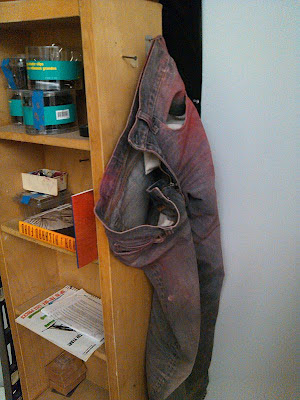dm simons is afraid.
He's afraid of the sudden knock on the door, the strangers with ill intentions who might burst in, drag him away from his work, his life. Afraid that at any moment the whole thing will be over, like it was for Aunt Mimi and Aunt Bertha when they got that knock on the door, in the 1940s in Europe, and ended up fighting for their lives in a Nazi death camp with six numbers tattooed in blue on their forearms.
"I remember seeing those numbers on their arms when I was a kid," says simons. "What struck me was that over time they'd become smudged."
In his studio in the DUMBO area of Brooklyn, simons talks about the direct influence of that memory on the way he makes his huge pastel drawings--drawing and pressing the chalky pigment onto the prepared surface, then smudging, blending, erasing, so that the edges of forms become indistinct, and the volumes of forms start to move slightly out of focus.
I first discovered simons' work online in 2011, and I responded immediately to the way that he combines bits and pieces of disparate images in ways that make surprising transitions from one part of the picture space to another. The content seems almost banal -- famous faces, dogs, people glimpsed at night in taxis, a pair of feet enclosed in dress shoes -- but I found myself thinking of them days later. My visit to his studio last week was the first time I saw his work in the flesh, so to speak, and their size (most of them are over 72 inches square) adds to their queasy, hypnotic power.
Asked about his process, simons replies with long discourses about his reading -- Hawthorne, Poe, Borges -- and the philosophy of vision. We move over to an area where there is a laptop, and he shows how he finds images online, from magazines and newspapers. "Something has to hit me," he says. "And then when I start drawing it out, it becomes a process of reducing the information, of working on the volumes, moving an edge back and forth across the picture."
We go to two new pictures pinned to the wall. Indicating an area in the image of a baby's head, he states: "I really need to rework this form here, until the volumes really start to emerge. This part is too pink, so I may even have to change the colors entirely."
Asked about the narrative content of his work, he replies: "It's true that I work with fragments, but I like to leave stuff out. If the viewer has to fill in some of the content for themselves, it actually helps the story."
For the next twelve months, simons will work out of this studio at the Marie Walshe Sharpe Foundation, which every year gives studio space to 17 artists out of over 1,000 applicants. Simons was the recipient of the Richard Florsheim Art Fund Studio Award for Older Artists, and he says that he has some grand plans for his work in the coming year. "I'm thinking of doing a panorama, something that goes around all the walls, which would give me space to have even abstract areas in the middle of all these images."
It's another commendable lesson from this remarkable artist: always continue to explore new possibilities, new moments for your art, no matter what your age.
For more about dm simons, here is my online interview with him from 2011.






